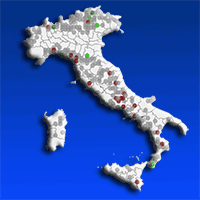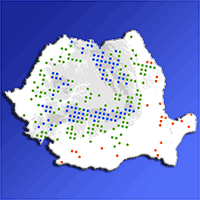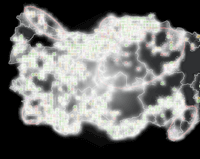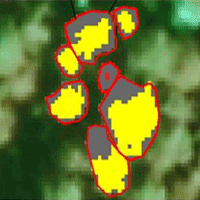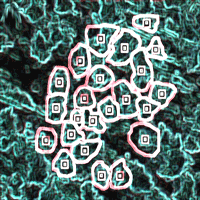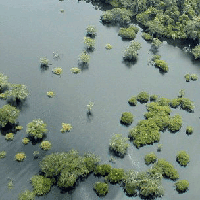The frequency of forest disturbances has increased in recent years, provoking widespread defoliation, crown dieback and tree mortality. The ICP Forests monitoring network offers a unique platform for observing the impacts on forests of heatwaves, droughts and other extreme climatic events, as well as the trends of defoliation and mortality. The Italian ICP Forests Level I network consists of 261 permanent plots where tree crown defoliation and damage symptoms are assessed visually each year by well-trained crews of the Corpo Forestale dello Stato (2001-2016) and the Carabinieri Forestale from 2017 onward. This paper aims to assess the main tree species’ responses, in terms of defoliation and mortality, to severe climatic events. The results are discussed in relation to species-specific physiological behaviour and bioclimatic regions. A significant trend toward increasing defoliation and mortality has been observed since 2010 in both conifers and broadleaves. Conifers (especially Picea abies), which are largely diffuse in the Alpine regions, have suffered from bark beetle outbreaks due to severe windstorms (such as Vaia in 2018) and recurrent dry years. In the temperate regions, characterised by deciduous broadleaved trees, the most relevant defoliation events coincided with the driest and hottest years, with low relative humidity (2012, 2017 and 2021-2022), only partially recovering in the subsequent years. Among them, Fagus sylvatica and Quercus cerris, along with increased defoliation, showed symptoms caused by fungi of the genus Biscogniauxia, causal agents of “charcoal canker”, in less favourable site conditions. Quercus pubescens was the most resilient species, able to restore its crown after defoliation. The Mediterranean forests, with evergreen broadleaved species, showed no significant trends but were impacted at the most drought-prone coastal sites. The findings evidenced that the current ICP Forests network in Italy represents a fundamental infrastructure for monitoring impacts and trends connected to climate change and species-specific responses. A local intensification of the grid would help to capture under-represented species or ecological conditions.
Keywords
, , , , , , ,
Citation
Bussotti F, Papitto G, Di Martino D, Cocciufa C, Cindolo C, Cenni E, Bettini D, Iacopetti G, Ghelardini L, Moricca S, Panzavolta T, Bracalini M, Pollastrini M (2024). Extreme climatic events, biotic interactions and species-specific responses drive tree crown defoliation and mortality in Italian forests. iForest 17: 300-308. - doi: 10.3832/ifor4531-017
Academic Editor
Marco Borghetti
Paper history
Received: Nov 29, 2023
Accepted: Jul 21, 2024
First online: Sep 30, 2024
Publication Date: Oct 31, 2024
Publication Time: 2.37 months
© SISEF - The Italian Society of Silviculture and Forest Ecology 2024
Open Access
This article is distributed under the terms of the Creative Commons Attribution-Non Commercial 4.0 International (https://creativecommons.org/licenses/by-nc/4.0/), which permits unrestricted use, distribution, and reproduction in any medium, provided you give appropriate credit to the original author(s) and the source, provide a link to the Creative Commons license, and indicate if changes were made.

Breakdown by View Type
(Waiting for server response...)
Article Usage
Total Article Views: 7416
(from publication date up to now)
Breakdown by View Type
HTML Page Views: 4496
Abstract Page Views: 1424
PDF Downloads: 1228
Citation/Reference Downloads: 0
XML Downloads: 268
Web Metrics
Days since publication: 441
Overall contacts: 7416
Avg. contacts per week: 117.71
Article Citations
Article citations are based on data periodically collected from the Clarivate Web of Science web site
(last update: Mar 2025)
(No citations were found up to date. Please come back later)
Publication Metrics
by Dimensions ©
Articles citing this article
List of the papers citing this article based on CrossRef Cited-by.
(1)
Alderotti F, Sillo F, Brilli L, Bussotti F, Centritto M, Ferrini F, Gori A, Inghes R, Pasquini D, Pollastrini M, Saurer M, Cherubini P, Balestrini R, Brunetti C (2023)Quercus ilex L. dieback is genetically determined: evidence provided by dendrochronology, δ
13C and SSR genotyping, Science of the Total Environment 904: 166809.
CrossRef |
Gscholar
(2)
Anderegg WRL, Hicke JA, Fisher RA, Allen CD, Aukema J, Bentz B, Hood S, Lichstein JW, Macalady AK, McDowell N, Pan Y, Raffa K, Sala A, Shaw JD, Stephenson NL, Tague C, Zeppel M (2015)Tree mortality from drought, insects, and their interactions in a changing climate. New Phytologist 208: 674-683.
CrossRef |
Gscholar
(3)
Arend M, Link RM, Zahnd C, Hoch G, Schuldt B, Kahmen A (2022)Lack of hydraulic recovery as a cause of post-drought foliage reduction and canopy decline in European beech. New Phytologist 234: 1195-1205.
CrossRef |
Gscholar
(4)
Attorre F, Francesconi F, De Sanctis M, Alfò M, Martella F, Valenti R, Vitale M (2014)Classifying and mapping potential distribution of forest types using a finite mixture model. Folia Geobotanica 49: 313-335.
CrossRef |
Gscholar
(5)
Battisti A, Benvegnù I, Colombari F, Haack RA (2014)Invasion by the chestnut gall wasp in Italy causes significant yield loss in
Castanea sativa nut production. Agricultural and Forest Entomology 16: 75-79.
CrossRef |
Gscholar
(6)
Billi P (2023)Mean annual and mean monthly temperature variation in Italy across the last century. Atti della Società Toscana Scienze Naturali, Memorie, Serie A 130: 105-115.
CrossRef |
Gscholar
(7)
Blumenstein K, Bußkamp J, Langer GJ, Schlöer R, Parra Rojas NM, Terhonen E (2021)Sphaeropsis sapinea and associated endophytes in Scots pine: interactions and effect on the host under variable water content. Frontiers in Forest and Global Change 4: 655769.
CrossRef |
Gscholar
(8)
Bontemps JD, Bouriaud O, Vega C, Bouriaud L (2022)Offering the appetite for the monitoring of European forests a diversified diet. Annals of Forest Science 79: 19.
CrossRef |
Gscholar
(9)
Bussotti F, Cozzi A, Cenni E, Bettini D, Sarti C, Ferretti M (2009)Measurement errors in monitoring tree crown conditions. Journal of Enviromental Monitoring 11: 769-773.
CrossRef |
Gscholar
(10)
Bussotti F, Bettini D, Carrari E, Selvi F, Pollastrini M (2023)Health condition of forests in central Italy (Tuscany) after recurrent droughts and heat events. Ecologia Mediterranea 49 (1): 37-47.
Gscholar
(11)
Bussotti F, Benassai D, Bettini D, Bracalini M, Capretti P, Cenni E, Cozzi A, Ferretti M, Ghelardini L, Iacopetti G, Moricca S, Panzavolta T, Pollastrini M, Stergulc F, Tiberi R (2024)Valutazione della condizione delle chiome degli alberi nelle aree permanenti di monitoraggio di Livello I e di Livello II. Manuale di Campagna - Aggiornamento 2023 [Assessment of tree crown conditions in Level I and Level II permanent monitoring plots. Field Manual - 2023 Update]. In: “Directive 2016/2284/UE - NEC (National Emission Ceilings). Criteri e metodi per il monitoraggio di ecosistemi forestali e acquatici soggetti ad inquinamento atmosferico e cambiamenti climatici. Manuali delle operazioni di campagna” (Papitto G, Cocciufa C, Pollastrini M, Bussotti F eds). Arma dei Carabinieri, Comando Unità Forestali, Ambientali e Agroalimentari con il contributo del finanziamento LIFE dell’Unione Europea, Rome, Italy, pp. 187-236. [in Italian]
Gscholar
(12)
Capretti P, Battisti A (2007)Water stress and insect defoliation promote the colonization of
Quercus cerris by the fungus
Biscogniauxia mediterranea. Forest Pathology 37 (2): 129-135.
CrossRef |
Gscholar
(13)
Chow GC (1960)Tests of equality between sets of coefficients in two linear regressions. Econometrica 28: 591-605.
CrossRef |
Gscholar
(14)
Colangelo M, Camarero JJ, Borghetti M, Gentilesca T, Oliva J, Redondo MA, Ripullone F (2018)Drought and
Phytophthora are associated with the decline of oak species in Southern Italy. Frontiers in Plant Science 9: 1595.
CrossRef |
Gscholar
(15)
Colombari F, Battisti A, Schroeder LM, Faccoli M (2012)Life-history traits promoting outbreaks of the pine bark beetle
Ips acuminatus (Coleoptera: Curculionidae, Scolytinae) in the south-eastern Alps. European Journal of Forest Research 131: 553-561.
CrossRef |
Gscholar
(16)
Cotrozzi L, Remorini D, Pellegrini E, Guidi L, Lorenzini G, Massai R, Nali C, Landi M (2017)Cross-talk between physiological and metabolic adjustments adopted by
Quercus cerris to mitigate the effects of severe drought and realistic future ozone concentrations. Forests 8: 148.
CrossRef |
Gscholar
(17)
D’Andrea E, Rezaie N, Battistelli A, Gavrichkova O, Kuhlmann I, Matteucci G, Moscatello S, Proietti S, Scartazza A, Trumbore S, Muhr J (2019)Winter’s bite: beech trees survive complete defoliation due to spring late-frost damage by mobilizing old C reserves. New Phytologist 224: 625-631.
CrossRef |
Gscholar
(18)
Dalponte M, Marzini S, Solano-Correa YT, Tonon G, Vescovo L, Gianelle D (2020)Mapping forest windthrows using high spatial resolution multispectral satellite images. International Journal of Applied Earth Observation and Geoinformation 93: 102206.
CrossRef |
Gscholar
(19)
Damesin C, Rambal S (1995)Field study of leaf photosynthetic performance by a Mediterranean deciduous oak tree (
Quercus pubescens) during a severe summer drought. New Phytologist 131: 159-167.
CrossRef |
Gscholar
(20)
De Vries W, Dobbertin M, Solberg HS, Van Dobben HF, Schaub M (2014)Impacts of acid deposition, ozone exposure and weather conditions on forest ecosystems in Europe: an overview. Plant and Soil 380 (1-2): 1-45.
CrossRef |
Gscholar
(21)
Eichhorn J, Roskams P, Potočić N, Timmermann V, Ferretti M, Mues V, Szepesi A, Durrant D, Seletković I, Schröck HW, Nevalainen S, Bussotti F, Garcia P, Wulff S (2020)Part IV: Visual assessment of crown condition and damaging agents. Version 2020-3. Manual on methods and criteria for harmonized sampling, assessment, monitoring and analysis of the effects of air pollution on forests. UNECE ICP Forests Programme Co-ordinating Centre, Thünen Institute of Forest Ecosystems, Eberswalde, Germany, pp. 49.
Online |
Gscholar
(22)
Economou A, Beccu E, Canu G, Cocco S, Bussotti F, Cenni E, Cozzi A, Ferretti M, Conceicao Andrada M, Sanchez Pena G (1994)Mediterranean forest trees. A guide for crown assessment. CEC - UN/ECE, Brussels, Belgium, pp. 156.
Gscholar
(23)
FAO (2020)Global forest resource assessment. Terms and definitions. Paper no. 118, FAO, Rome, Italy, pp. 32.
Gscholar
(24)
Ferretti M (2021)New appetite for the monitoring of European forests. Annals of Forest Science 78: 94.
CrossRef |
Gscholar
(25)
Fotelli MN, Radoglou KM, Constantinidou HIA (2000)Water stress responses of seedlings of four Mediterranean oak species. Tree Physiology 20 (16): 1065-1075.
CrossRef |
Gscholar
(26)
Gallé A, Haldimann P, Feller U (2007)Photosynthetic performance and water relations in young pubescent oak (
Quercus pubescens) trees during drought stress and recovery. New Phytologist 174: 799-810.
CrossRef |
Gscholar
(27)
Gazol A, Camarero J (2022)Compound climate events increase tree drought mortality across European forests. Science of the Total Environment 816: 151604.
CrossRef |
Gscholar
(28)
George J-P, Bürkner P-C, Sanders TGM, Neumann M, Cammalleri C, Vogt JV, Lang M (2022)Long-term forest monitoring reveals constant mortality rise in European forests. Plant Biology 24: 1108-1119.
CrossRef |
Gscholar
(29)
Gobiet A, Kotlarski S, Beniston M, Heinrich G, Rajczak J, Stoffel M (2014)21st century climate change in the European Alps: a review. Science of the Total Environment 493: 1138-1151.
CrossRef |
Gscholar
(30)
Iacopetti G, Selvi F, Bussotti F, Pollastrini M, Jucker T, Bouriaud O (2023)Tree diversity and identity modulate the growth response of thermophilous deciduous forests to climate warming. Oikos 2023 (3): e08875.
CrossRef |
Gscholar
(31)
IPCC (2021)Climate change 2021: the physical science basis. Contribution of Working Group I to the Sixth Assessment Report of the Intergovernmental Panel on Climate Change. Cambridge University Press, Cambridge, United Kingdom and New York, NY, USA, pp. 2391.
CrossRef |
Gscholar
(32)
Jaime L, Battlori E, Ferretti M, Lloret F (2022)Climatic and stand drivers of forest resistance to recent bark beetle disturbance in European coniferous forests. Global Change Biology 28: 2830-2841.
CrossRef |
Gscholar
(33)
Klap JM, Oude Voshaar JH, De Vries W, Erisman JW (2000)Effects of environmental stress on forest crown condition in Europe. Part IV: Statistical analysis of relationships. Water, Air, and Soil Pollution 119: 387-420.
CrossRef |
Gscholar
(34)
Lorenzini G, Pellegrini E, Campanella A, Nali C (2014)It’s not just the heat and the drought: the role of ozone air pollution in the 2012 heat wave. Agrochimica 58: 40-42.
Gscholar
(35)
Moricca S, Ginetti B, Ragazzi A (2012)Species- and organ-specificity in endophytes colonizing healthy and declining Mediterranean Oaks. Phytopathologia Mediterranea 51: 587-598.
Online |
Gscholar
(36)
Müller E, Stierlin HR (1990)Tree crown photos. Sanasilva. Swiss Federal Institute for Forest Snow and Landscape Research. Birmensdorf, Switzerland, pp. 129.
Gscholar
(37)
Murolo S, Concas J, Salerno A, Maiorano F, Cingolani L, Carloni F, Moricca S, Romanazzi G (2018)Status of charcoal canker on oak trees at a site of community importance: case study of the relict Castelfidardo forest (SIC Area IT520008, Castelfidardo, AN, Italy). Forests 12 (8): 1032.
CrossRef |
Gscholar
(38)
Nardini A, Lo Gullo MA, Salleo S (1999)Competitive strategies for water availability in two Mediterranean
Quercus species. Plant, Cell and Environment 22: 109-116.
CrossRef |
Gscholar
(39)
Nardini A, Pitt F (1999)Drought resistance of
Quercus pubescens as a function of root hydraulic conductance, xylem embolism and hydraulic architecture. New Phytologist 143 (3): 485-493.
CrossRef |
Gscholar
(40)
Ognjenović M, Seletković I, Potočić N, Marušić M, Tadić MP, Jonard M, Rautio P, Timmermann V, Lovreškov L, Ugarković D (2022)Defoliation change of European beech (
Fagus sylvatica L.) depends on previous year drought. Plants 11: 730.
CrossRef |
Gscholar
(41)
Patacca M, Lindner M, Lucas-Borja ME, Cordonnier T, Fidej G, Gardiner B, Hauf Y, Jasinevičius G, Labonne S, Linkevičius E, Mahnken M, Milanovic S, Nabuurs G-J, Nagel TA, Nikinmaa L, Panyatov M, Bercak R, Seidl R, Ostrogović M, Sever Z, Socha J, Thom D, Vuletic D, Zudin S, Schelhaas M-J (2023)Significant increase in natural disturbance impacts on European forests since 1950. Global Change Biology 29: 1359-1376.
CrossRef |
Gscholar
(42)
Pollastrini M, Puletti N, Selvi F, Iacopetti G, Bussotti F (2019)Widespread crown defoliation after a drought and heat wave in the forests of Tuscany (central Italy) and their recovery - A case study from summer 2017. Frontiers in Forests and Global Change 2: 74.
CrossRef |
Gscholar
(43)
Potočić N, Timmermann V, Ognjenović M, Kirchner T, Prescher A-K, Ferretti M (2021)Tree health is deteriorating in the European forests. ICP Forests Brief no. 5, Programme Co-ordinating Centre of ICP Forests, Thünen Institute of Forest Ecosystems, Braunschweig, Germany, pp. 6.
Online |
Gscholar
(44)
Quacchia A, Moriya S, Bosio G, Scapin I, Alma A (2008)Rearing, release and settlement prospect in Italy of
Torymus sinensis, the biological control agent of the chestnut gall wasp
Dryocosmus kuriphilus. Biocontrol 53: 829-839.
CrossRef |
Gscholar
(45)
Rebetez M, Mayer H, Dupont O, Schnindler D, Gartner K, Kropp J, Menzel A (2006)Heat and drought 2003 in Europe: a climate synthesis. Annals of Forest Science 63: 567-575.
CrossRef |
Gscholar
(46)
Rita A, Camarero JJ, Nolè A, Borghetti M, Brunetti M, Pergola N, Serio C, Vicente-Serrano SM, Tramutoli V, Ripullone F (2020)The impact of drought spells on forests depends on site conditions: the case of 2017 summer heat wave in southern Europe. Global Change Biology 26: 851-863.
CrossRef |
Gscholar
(47)
Seidl R, Schelhaas MJ, Rammer W, Verkerk J (2014)Increasing forest disturbances in Europe and their impact on carbon storage. Nature Climate Change 4: 806-810.
CrossRef |
Gscholar
(48)
Senf C, Buras A, Zang CS, Rammig A, Seidl R (2020)Excess forest mortality is consistently linked to drought across Europe. Nature Communications 11 (1): 6200.
CrossRef |
Gscholar
(49)
SNPA (2023)Il clima in Italia nel 2022 [Italian climate 2022]. Report Sistema SNPA 36/2023, Rome, Italy, pp. 178. [in Italian]
Online |
Gscholar
(50)
Spinoni J, Vogt JV, Naumann G, Barbosa P, Dosio A (2018)Will drought events become more frequent and severe in Europe? International Journal of Climatology 38: 1718-1736.
CrossRef |
Gscholar
(51)
Tognetti R, Ridder H-W, Beres C, Fenyvesi A, Raschi A (1996)Comparison of water flow, cavitation and water status of
Quercus cerris and
Quercus petraea trees with special reference to computer tomography. Plant Cell and Environment 19: 928-938.
CrossRef |
Gscholar
(52)
Tognetti R, Cherubini P, Marchi S, Raschi A (2007)Leaf traits and tree rings suggest different water-use and carbon assimilation strategies by two co-occurring
Quercus species in a Mediterranean mixed forest stand in Tuscany (Italy). Tree Physiology 27: 1741-1751.
CrossRef |
Gscholar
(53)
Vacchiano G, Garbarino M, Borgogno M, Mondino E, Motta R (2012)Evidences of drought stress as a predisposing factor to Scots pine decline in Valle d’Aosta (Italy). European Journal of Forest Research 131: 989-1000.
CrossRef |
Gscholar
(54)
Walthert L, Ganthaler A, Mayr S, Saurer M, Waldner P, Walser M, Zweifel R, Von Arx G (2021)From the comfort zone to crown dieback: sequence of physiological stress thresholds in mature European beech trees across progressive drought. Science of the Total Environment 753: 141792.
CrossRef |
Gscholar
(55)
Zeileis A, Leisch F, Hornik K, Kleiber C (2002)strucchange: an R package for testing for structural change in linear regression models. Journal of Statistical Software 7 (2): 1-38.
Gscholar
